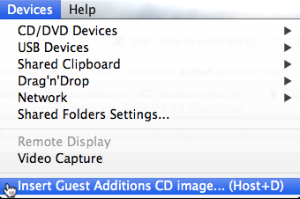| Section | |||||||||||||||||||||||||||||||||||||||||
|---|---|---|---|---|---|---|---|---|---|---|---|---|---|---|---|---|---|---|---|---|---|---|---|---|---|---|---|---|---|---|---|---|---|---|---|---|---|---|---|---|---|
|
Creating the virtual machine
...
| Code Block |
|---|
vboxsf 47936 0 vboxvideo 12669 1 vboxguest 293037 6 vboxsf drm 335594 3 vboxvideo |
Uninstall guest additions by:
| Code Block |
|---|
sudo zypper rm virtualbox-guest-kmp-default virtualbox-guest-tools virtualbox-guest-x11 |
This will prompt for the root password 'metv1ew!'
Install steps
These steps use the Mac OSX version of VirtualBox. Other systems may be slightly different.
- Start up the virtual machine (VM) and let it start up fully.
First check that the necessary kernel files are installed:
Code Block zypper search kernel-devel
If not, install them with the command:
Code Block sudo zypper install kernel-devel
The installation needs to be done as the root user. This command will prompt for the root password '
metv1ew!'The 'make' and 'gcc' packages are also required but these are normally available by default in the OpenIFS virtual machine.
- With the virtual machine as the active window, select the 'Devices' menu and the 'Install guest additions CD image..
A popup window should appear in the virtual machine showing the CD. - In the virtual machine, open a Terminal window from the openSUSE icon and 'Applications' menu
In the Terminal, change to the directory where the VBoxAdditions CD was mounted. This will be under the /run/media directory, followed by the username.
Code Block title e.g. cd /run/media/openifs/VBOXADDITIONS_4.3.34_104062
(older systems may use /var/run/media instead).
To start the installation of the Guest Additions, type the following in the Terminal:
Code Block sudo ./VBoxLinuxAdditions.run
This will prompt for the root password, usually
'metv1ew!'Info The installation may report that Guest Additions is already installed and ask you to confirm.
The installation only takes a few minutes.
- Reboot the virtual machine for the changes to take effect.
...
| Info |
|---|
Please note that the user 'openifs' does not exist on the earlier OpenIFS Virtual Machines. |
...
Check that the Settings for the VM are set to 'Bidirectional'. Also, when the VM is running, check that the menu option "Devices" -> "Drag'n'Drop" is also set to Bidirectional.
...
The name 'shared_folder' should be the same as the name of the shared_folder in the VM Settings panel.
Shared folders stop working after kernel update
If a system update has updated the kernel files and shared folders have stopped working, reinstall the Guest Additions software. Guest Additions adds files to the kernel and these must be reinstalled if the kernel is changed.


